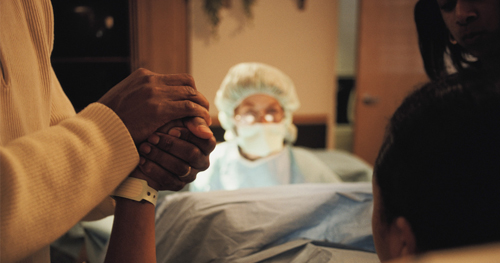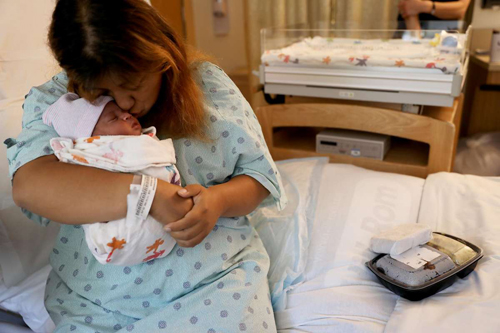‘If not me, then who else?’ Ensuring rural maternal, obstetric health equity
After Nikki Greenaway gave birth to her first child in 2011, she knew something was wrong. Caught in the throes of postpartum depression, she sought advice from family and friends but repeatedly had her concerns dismissed – “Oh, it’s just the blues,” they told her. Greenaway has been a board-certified family nurse practitioner since 2012 and is also an international board-certified lactation specialist, but a decade ago no one was talking much about maternal health. She felt lost and unsure of where to turn.
“Even as a health care provider, I didn’t quite know what was happening to me or where to go for help,” Greenaway says. “I wasn’t given information from the hospital. After you have the baby and leave the hospital it’s like you fall off a cliff. As I dove deeper into depression, my older brother came to me and said, ‘I think you’re supposed to be the change that we need.’”
 |
 |
 |
 |
 |
Carrie Cochran-
|
Nikki Greenaway
|
Julia Interrante
|
Elizabeth Lewis
|
Mariana Tuttle
|
Shifting her focus to how she could help others in similar situations worked as a sort of therapy for Greenaway, and in 2012 she founded Bloom Maternal Health. Currently serving patients near New Orleans, La., and Houston, Texas, where Greenaway and her family live, Bloom provides postpartum support through home and telehealth visits, care coordination, and referrals, along with postpartum education through classes and other resources. Greenaway has partnered with organizations such as homeless shelters, the Women, Infants, and Children Program, and Healthy Start to reach the rural and lower socioeconomic status families that need her help the most.
“The foundation of our practice is meeting the client where they are, literally and figuratively,” she says. “When I started doing home visits, it didn’t catch on right away – people would ask, ‘Why would I want anybody in my home?’ Because that’s what our elders used to do. That’s our village. That’s how we’re supposed to get care and get support, but we’re parenting in silos right now, and people are recovering in silos. My clients want to get better but there are so many social determinants of health in their way.”
A story of access and disparities
Over the last decade Greenaway has helped hundreds of families gain access to health care and other resources, but across the country the maternal health care crisis has gotten worse. According to a 2022 March of Dimes report, 36 percent of all U.S. counties are considered maternity care deserts, with 2.2 million women living in areas with no maternity care and 4.7 million experiencing limited access. Two in three maternity care deserts are in rural counties, where approximately 450,000 babies are born each year.
“We’re in a maternal and infant health crisis in this country,” says Elizabeth Lewis, March of Dimes director of maternal and infant health. “The U.S. remains one of the most dangerous developed nations to deliver a baby. Living in areas without or with limited access to maternity care is putting moms and babies at risk of serious health complications and increased maternal and infant mortality and morbidity, such as low birth weight and preterm birth. A lot of that is a story of access and disparities.”
When looking at the maternal mortality crisis through a rural lens, the situation becomes even more dire. The University of Minnesota Rural Health Research Center reports that 53 rural counties lost obstetric care from 2014 through 2018, and out of 1,976 rural counties in the country, 1,045 have never had hospital-based OB services. The reasons behind rural OB unit closures are myriad, with patient volume, financial viability, and patient safety all cited as overlapping factors.
“Rural areas are pretty diverse, but one thing they all have in common is fewer people, meaning facilities see fewer pregnant people coming through their doors and fewer births per year,” says Mariana Tuttle, a University of Minnesota research fellow. “Fewer births mean fewer dollars, but you’re still having to maintain those services, and if you only see 20 or 25 births per year, your clinicians and staff aren’t getting the chance to train and feel confident about the care they’re providing.”
 |
According to Carrie Cochran-McClain, NRHA chief policy officer, another piece of the puzzle is reimbursement. Many rural births – in some areas, up to 80 or 90 percent – are insured by Medicaid, which reimburses for childbirth at a lower rate than private payers. When rising costs lead rural facilities to shutter their OB units – and in some cases, the hospital entirely – the consequences can be devastating. The University of Minnesota study shows rural residents had a 9 percent greater probability of severe maternal morbidity and mortality compared with urban residents, and the Government Accountability Office reports Black women in rural areas are three times more likely to die from pregnancy-related causes compared to white women.
“Just because you don’t have somewhere to go doesn’t mean that people stop having babies,” Tuttle says. “Sometimes moms can’t get to the next closest place and you know they’ll end up in your ER anyway, and it can be an ethical issue and a practical one.”
No easy solutions
When facing such a multifaceted problem, solutions can be just as complex, but resilient rural health care providers across the country have been finding ways to fill gaps in care in their unique communities. In some remote parts of Alaska where weather and transportation are major barriers, the state Medicaid program flies pregnant patients into a local hospital, where they stay for about a month before they give birth. In Roaring Forks Valley, Colo., the Alma peer-to-peer mentoring program is tailored to the area’s large population of Spanish-speaking moms, helping them navigate postpartum challenges such as anxiety and depression. And at Northern Light Inland Hospital in rural Maine, the Tree of Hope perinatal support group meets at the facility and is staffed by one of the hospital’s nurses.
In addition to access challenges, Greenaway adds that many of her clients simply do not feel their providers are listening to or adequately addressing their concerns – something she has experienced herself in multiple health care settings. She says encouraging providers to take their patients’ symptoms more seriously could go a long way toward reducing maternal morbidity and mortality – along with provider education, as CDC data shows up to 80 percent of maternal deaths are preventable.
“There’s this narrative of a parent having a baby or being pregnant and telling a provider, ‘Hey, I don’t feel well. Something’s not right,’ and them being dismissed,” Greenaway says. “We are the liaison – we are helping them access care, get food, get childcare. That’s not what a typical nurse practitioner does, but it should be. We’re trying to fill in the gaps – and there are so many gaps.”
To make lasting changes, Cochran-McClain says policy changes are in order. One of NRHA’s priorities for 2023 is making sure workforce and telehealth components of the Rural Maternal and Obstetric Modernization of Services (Rural MOMs) Act are adequately funded, and the association’s Government Affairs team wants to see rural communities reflected in the Black Maternal Health “Momnibus,” which aims to address poor outcomes experienced by women of color. NRHA is also working to develop an OB readiness grant program or resource so rural hospitals that experience low birth volumes can be adequately prepared when handling an unexpected labor and delivery.
Julia Interrante, University of Minnesota Rural Health Research Center research fellow, adds that state uptake of the permanent expansion of Medicaid coverage after birth from 60 days to a full year could make a difference for many uninsured rural residents and particularly women of color, a change that NRHA advocated for in the FY23 Omnibus spending bill.
“The areas where we see rural OB units closing are often in the South with more Black birthing people,” Interrante says. “We also see differences based on race and ethnicity regarding access to insurance for rural folks, which impacts care. About half of all deaths occur after birth, and with Medicaid you lose coverage within 60 days if you gained access because of pregnancy. If you’re losing access you’re probably not going in to seek care even if you have a problem.”
 |
Interrante and Greenaway both state that targeted investment in rural communities – and particularly rural communities of color – is needed to create or sustain local access to care. No matter what policies are pursued going forward, it is imperative for people who live in rural places to have a seat at the table where solutions are being discussed.
“If you don’t have rural people trying to understand the problem and how to help, it’s a mismatch,” Tuttle says. “It’s important that rural folks are leading the work and informing the decisions.”
‘I’m trying to save my own life’
While discussion surrounding the rural maternal health crisis is finally gaining national attention, for many health care providers and advocates, the issue remains deeply personal. Cochran-McClain has experienced health challenges during both of her pregnancies and believes she would have had different outcomes if she had lived in a rural or remote area.
“As a mom of two kids, I think about how hard it would have been not to have the immediate access to care I did,” she says. “As someone who has long roots in rural Montana, if I would have lived in that kind of environment I may not have had the same access. I feel it is truly an equity issue and every rural family deserves to be able to go through this stage of life in a healthy and safe way.”
Greenaway also sees herself in her patients, knowing that while she is a mom and a health care provider with three degrees, before all of that she is a Black woman. She feels that the only reason she survived her personal experiences with postpartum depression and reproductive health is that it “just wasn’t my time.”
“I’ve seen it happen so many times,” she says. “In one week in 2019 I had a patient who had a stillborn at 39 weeks, I had a mom who died during pregnancy, and a mom who had a miscarriage. I’m like – okay, what could we have done differently? I’m always trying to find a lesson in the grief. I’m passionate about it because it’s me. I’m trying to save my own life and that of my mother and my sisters and my cousins. It’s too close to me not to do anything with the knowledge and skills that I have. If not me, then who else?”
